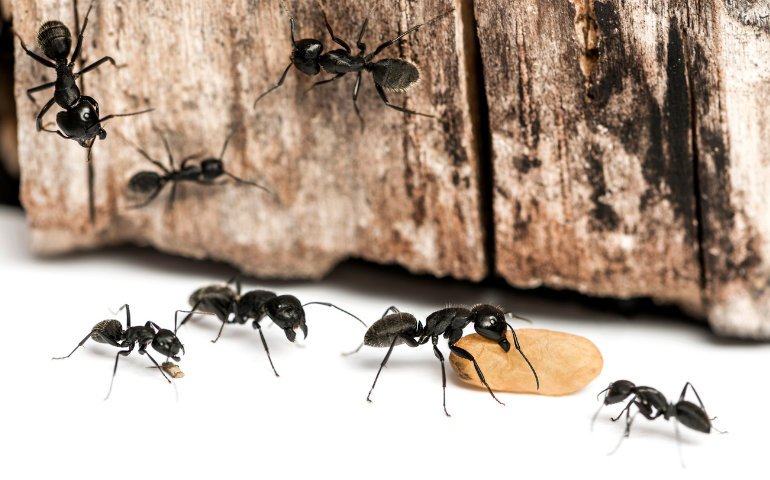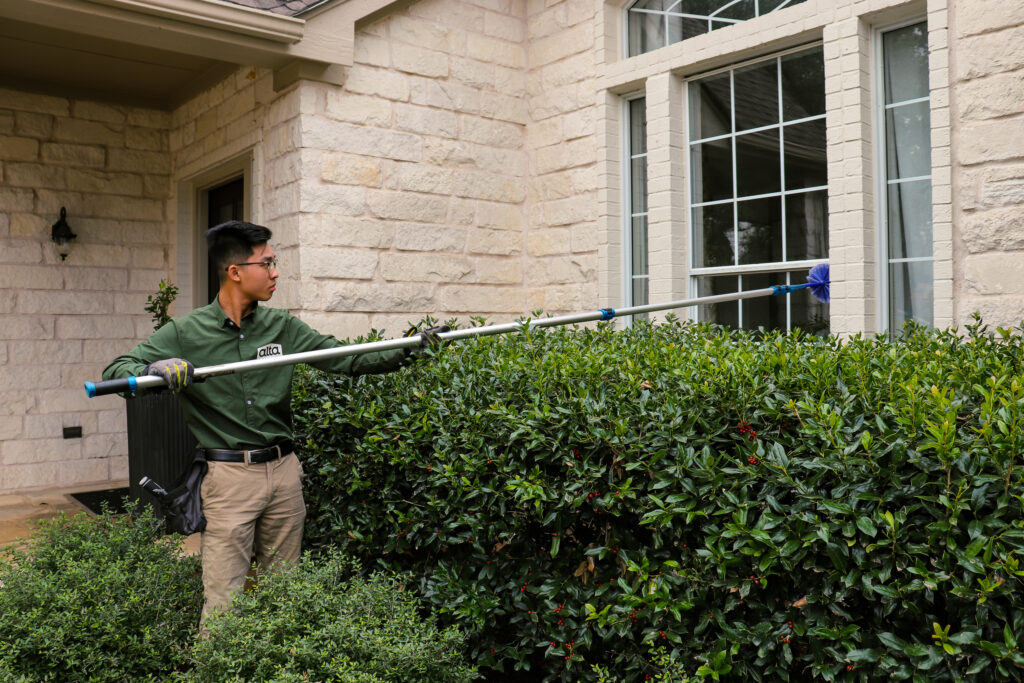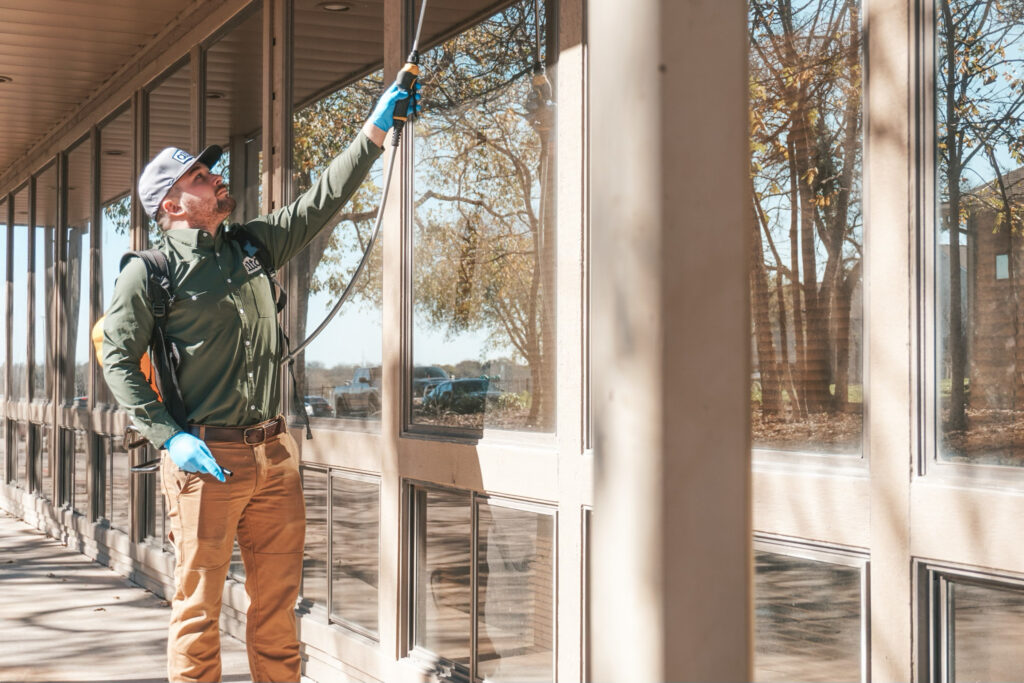There are thousands of ant species in the world, but only a few are a real threat to your home. Some ants are just a minor nuisance, while carpenter ants can cause serious damage by tunneling through wood.
If you want to protect your home, it’s important to spot carpenter ants early and deal with them before they spread. This article will walk you through how to get rid of carpenter ants and keep them from weakening your property.
Identifying Carpenter Ants and Their Traits
Carpenter ants often build nests in damp or decaying wood. As they dig, they create smooth tunnels that connect different parts of the colony.
You’ll usually find their nests in hollow spaces like tree branches, door frames, window sills, or even wall cavities inside the house.

Carpenter ants don’t eat wood, but they damage it by hollowing it out. A common sign of their presence is frass. This is the fine sawdust-like material they leave behind while tunneling.
If you notice piles of frass near wooden areas, it often points to an active nest nearby. Spotting this early makes it much easier to deal with both winged and crawling carpenter ants before the problem spreads.
How to Get Rid of Carpenter Ants Outside
1. Use Poison Bait for Fast Carpenter Ant Control
If you can’t get to the nest itself, bait is one of the most effective options. Look for a slow-acting bait made for carpenter ants and mix it with a little sugar and milk to make it more appealing. Place it near their trails or around spots where you think the nest might be. The workers will take it back and share it with the colony, which helps wipe out the population over the course of a few days.
Skip the quick-kill sprays since those only take care of the ants you see and often just make the rest of the colony relocate. If you have pets or kids around, go with bait stations that are tamper-proof so it’s safer to use inside or near the house.
2. Apply Insecticide Dust Directly to Nests
When you’re lucky enough to actually find the nest, insecticide dust is a strong way to hit the colony directly. Use a dust labeled for carpenter ants and apply it right into the nest opening. This goes after the workers and the queen, which speeds things up.

The dust is potent, so always follow the safety instructions on the product and wear protective gear. After all, safety comes first! Keep in mind it’s not the best choice if you’ve got pets or kids who might come into contact with it.
3. Use Boric Acid and Sugar Mixture
Mix about two parts boric acid with one part powdered sugar and place small amounts in shallow lids or bottle caps near where you see activity. The sugar draws them in, and the boric acid does the work once they carry it back to the colony.
This method isn’t instant, so you’ll need some patience. It can take a few days before you notice a difference in the nest. Just make sure you keep the bait somewhere pets or kids can’t get to since boric acid is toxic if ingested.
4. Eliminate Ant Trail Scents
Carpenter ants depend on their scent trails to find their way back and forth between food and the nest. If you break those trails, it throws them off. An easy way to do this is by spraying paths with soapy water or a mix of vinegar and water.
You can also use essential oils like citrus, tea tree, or cedarwood on cotton balls to wipe along the areas they travel. Once you clear these trails regularly, the ants lose their bearings, and it makes it harder for them to keep coming back.
5. Spread Diatomaceous Earth Around Nest Sites
Diatomaceous earth is a fine, natural powder made from fossilized algae, and it’s very effective against carpenter ants. It works by scratching their outer shell and slowly drying them out. To use it, sprinkle a thin layer around nest entrances, along visible trails, and in places where you notice ant activity.
If you suspect the colony is hiding inside a wall or structure, you can drill small holes about an inch wide near the base and puff the powder inside. Just be careful not to inhale it, as it can irritate your lungs. The big advantage is that diatomaceous earth is non-toxic for kids and pets, which makes it one of the safer long-term options for treating carpenter ants outdoors.
6. Consider Professional Pest Management Services
Unfortunately, a carpenter ant infestation is not always something you can fully tackle on your own. That’s when you need Alta Pest Control to help. They start by checking your home carefully, looking for hidden nests and signs of damage you might miss. Once they know where the problem is, they use treatments that go straight to the colonies.
At the same time, they know things that make ants stick around, like damp areas or cracks that let them inside. With their help, you’ll be able to take care of both the ants and the causes behind them. So the issue won’t just pause for a while, but you’ll have it under control.
How to Check for Carpenter Ants
Step 1: Confirm It’s Carpenter Ants, Not Termites
Before you begin, take time to make sure the insects you see are carpenter ants instead of termites. Carpenter ants are large and usually black or dark brown. They have segmented bodies, six legs, and bent antennae. Reproductive carpenter ants have wings, while worker ants do not. Termites look different because their bodies are lighter in color, their antennae are straight, and their shape is less defined.
Step 2: Check for Sawdust-Like Debris
Carpenter ants do not eat wood, but they hollow it out to make tunnels. When they do this, they leave behind a material called frass. It looks like fine wood shavings but often includes bits of waste as well. If you see small piles of this sawdust near doors, windows, or baseboards, it usually means there is an active nest close by.
Step 3: Inspect for Damaged Wood
Look carefully at wooden areas in your home, paying special attention to places that stay damp. Window sills, door frames, beams, and even old tree stumps outside are all common nesting spots. Carpenter ants prefer rotting or decaying wood, so search for holes, tunnels, or soft areas that suggest they are hollowing it out.
Step 4: Use Bait to Attract Ants
If you think ants are present but cannot see them, place small pieces of sweet food near areas of activity. Fruits like melon or drops of honey work well because carpenter ants are strongly attracted to sugar. This makes it easier to bring them out of hiding so you can watch their movements.
Step 5: Trace Ants to Their Nest
Once the ants take the bait, follow their trail slowly and carefully. They usually travel back to their colony through cracks in walls, floors, or door frames. If you can locate the nest and it is within reach, you can remove or treat it directly. If the nest is hidden, using poisonous bait may be necessary. This takes longer to work, sometimes several days, but it is often the most reliable way to eliminate the entire colony.

How to Prevent Carpenter Ants from Coming Back
Clear Away Excess Items and Messes
Carpenter ants like quiet, hidden spots to build their nests. Keeping your home tidy makes it harder for them to settle in. Get rid of piles of objects or debris that could give them cover. At the same time, fix any plumbing leaks or damp areas. Rotting or wet wood is especially inviting to these ants, so keeping things dry is key.
Ensure Your Home is Properly Sealed
Look closely at your foundation, walls, windows, and doors for small cracks or gaps. Sealing these openings will stop ants from slipping inside. Adding screens to windows and doors gives you extra protection and helps keep ants out while still letting fresh air in.
Maintain the Yard and Remove Outdoor Debris
How can you prevent and get rid of carpenter ants outdoors? First, cut back tree branches that touch or hang over your roof, since ants use them as easy pathways into the house. Then, clear away wood piles, fallen branches, and garden debris near your foundation, because these spots make ideal nesting sites.
Keep Food Areas Clean and Address Moisture Issues
Indoors, carpenter ants are usually looking for food or water. Sweep and wipe down counters and floors so crumbs do not build up. Clean up sugary spills right away, since ants are strongly attracted to sweet liquids. Fix dripping taps and remove standing water around sinks, tubs, or appliances to make your home less appealing.
Share article:
